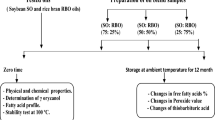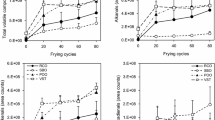Abstract
In this study, the effect of sesame oil (SEO) and rice bran oil (RBO) on the rancidity of canola oil (CAO) during the process of frying potato pieces at 180 °C was investigated. The SEO and RBO were added to the CAO at levels of 3 and 6%. Frying stability of the oil samples during the frying process was measured on the basis of total polar compounds (TPC) content, conjugated diene value (CDV), acid value (AV), and carbonyl value (CV). In general, frying stability of the CAO significantly (P < 0.05) improved in the presence of the SEO and RBO. The positive effect of the SEO on the stability of the CAO was more than that of the RBO. Increasing the amounts of SEO and RBO from 3 to 6% led to decreases in the TPC and AV, and increases in the CDV and CV of the CAO during the frying process. The best frying performance for the CAO was obtained by use of 3% of both SEO and RBO together (CAO/SEO/RBO, 94:3:3 w/w/w).

Similar content being viewed by others
References
Nawar WW (1996) Lipids. In: Fennema OR (ed) Food chemistry. Marcel Dekker, Inc., New York, pp 225–320
Barbosa-Canovas V (1999) Deep-fat frying, fundamentals and applications. Aspen Publication, Maryland
Mensink RP, Katan MB (1990) Effect of dietary trans fatty acids on high-density and low-density lipoprotein cholesterol levels in healthy subjects. N Eng J Med 329:439–445
Ito N, Hirose M, Fukushima S, Tsuda H, Shirai T, Tatematsu M (1986) Studies on antioxidants: their carcinogenic and modifying effects on chemical carcinogenesis. Food Chem Toxicol 24:1071–1082
Whysner J, Wang CX, Zang E, Iatropoulos MJ, Williams GM (1994) Dose response of promotion by butylated hydroxyanisole in chemically initiated tumors of the rat forestomach. Food Chem Toxicol 32:215–222
Williams GM, Iatropoulos MJ, Whysner J (1999) Safety assessment to butylated hydroxyanisole and butylated hydroxytoluene as antioxidant food additives. Food Chem Toxicol 37:1027–1038
Namiki M (1995) The chemistry and physiological functions of sesame. Food Rev Intern 11:281–329
Gopala Krishna AG (2002) Nutritional components of rice bran oil in relation to processing. Lipid Technol 14:80–84
Petukhov I, Malcolmson LJ, Przybylski R, Armstrong L (1999) Frying performance of genetically modified canola oils. J Am Oil Chem Soc 76:627–632
Tyagi VK, Vasishtha AK (1996) Changes in the characteristics and composition of oils during deep-fat frying. J Am Oil Chem Soc 73:499–506
Farhoosh R, Niazmand R, Rezaei M, Sarabi M (2008) Kinetic parameter determination of vegetable oil oxidation under Rancimat test conditions. Eur J Lipid Sci Technol 110:587–592
Shantha NC, Decker EA (1994) Rapid, sensitive, iron-based spectrophotometric methods for determination of peroxide values of food lipids. J AOAC Int 77:21–424
CS AO (1993) Official methods and recommended practices of the American Oil Chemists’ Society. AOCS Press, Champaign
Schulte E (2004) Economical micromethod for determination of polar components in frying fats. Eur J Lipid Sci Technol 106:772–776
Saguy IS, Shani A, Weinberg P, Garti N (1996) Utilization of jojoba oil for deep-fat frying of foods. Lebensm Wiss u-Technol 29:573–577
Endo Y, Li CM, Tagiri-Endo M, Fugimoto K (2001) A modified method for the estimation of total carbonyl compounds in heated and frying oils using 2-propanol as a solvent. J Am Oil Chem Soc 10:1021–1024
Farhoosh R, Moosavi SMR (2006) Determination of carbonyl value in rancid oils: a critical reconsideration. J Food Lipids 13:298–305
Mendez E, Sanhueza J, Speisky H, Valenzuela A (1996) Validation of the Rancimat test for the assessment of the relative stability of fish oils. J Am Oil Chem Soc 73:1033–1037
Pantzaris TP (1998) Comparison of monounsaturated and polyunsaturated oils in continuous frying. Gras Aceit 49:319–352
Firestone D (1993) Worldwide regulation of frying fats and oils. Inform 4:1366–1371
Shahidi F, Wanasundara UN (1997) Measurement of lipid oxidation and evaluation of antioxidant activity. In: Natural antioxidants, chemistry, health effects and applications. AOCS Press, Champaign, pp 1–10
Chatha SAS, Anwar F, Manzoor M, Bajwa JR (2006) Evaluation of the antioxidant activity of rice bran extracts using different antioxidant assays. Grass Aceit 57:328–335
Nasirullah (2001) Development of deep frying edible vegetable oil. J Food Lipids 8:295–304
Chatzilazarou A, Gortzi O, Lalas S, Zoidis E, Tsaknis J (2006) Physicochemical changes of olive oil and selected vegetable oils during frying. J Food Lipids 13:27–35
Gopala Krishna AG, Hemakumar KH, Sakina Khatoon (2006) Study on the composition of rice bran oil and its higher free fatty acids value. J Am Oil Chem Soc 83:117–120
Matthhaus B (2006) Utilization of high-oleic rapeseed oil for deep-fat frying of French fries compared to other commonly used edible oils. Eur J Lipid Sci Technol 108:200–211
Woyewoda AD, Shaw SJ, Ke PJ, Burns BG (1986) Recommended laboratory method for assessment of fish quality. Canadian Technical Report Fisheries and Aquatic Sciences No. 1448
Farhoosh R, Moosavi SMR (2008) Carbonyl value in monitoring of the quality of used frying oils quality. Anal Chim Acta 617:18–21
Author information
Authors and Affiliations
Corresponding author
About this article
Cite this article
Farhoosh, R., Esmaeilzadeh Kenari, R. Anti-Rancidity Effects of Sesame and Rice Bran Oils on Canola Oil During Deep Frying. J Am Oil Chem Soc 86, 539–544 (2009). https://doi.org/10.1007/s11746-009-1382-7
Received:
Revised:
Accepted:
Published:
Issue Date:
DOI: https://doi.org/10.1007/s11746-009-1382-7




